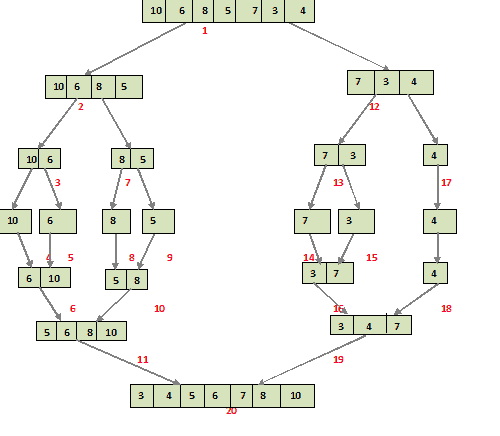1. 简介
本篇文章将带你深入理解 归并排序(Merge Sort)算法及其在 Java 中的实现方式。
归并排序是一种非常高效的排序方法,它基于 "分治思想(Divide and Conquer)" 实现。如果你追求稳定性和效率,尤其是在处理大规模数据时,归并排序是一个值得掌握的经典算法。
2. 算法原理
✅ 归并排序是一种典型的“分治”算法,它的核心思想是:
- 将原问题不断拆分成更小的子问题,直到每个子问题足够简单可以直接解决;
- 然后自底向上地合并这些子问题的解,最终得到完整问题的答案。
由于其天然的递归特性,归并排序非常适合用递归来实现。
整个过程可以分为两个阶段:
- 划分(Divide)阶段:
- 把数组从中间分成两部分;
- 对每一半继续递归划分,直到数组长度为 1。
- 合并(Conquer)阶段:
- 自底向上地将两个已排序的子数组合并成一个有序数组;
- 最终完成整个数组的排序。
来看一个例子:数组 {10, 6, 8, 5, 7, 3, 4} 的完整归并排序流程如下图所示:
从图中可以看到,数组被不断二分,直到只剩单个元素;然后开始合并,并在合并过程中进行排序,最终得到一个完全有序的数组。
3. Java 实现
我们来动手写一个归并排序的 Java 实现版本。
3.1 主函数 mergeSort
public static void mergeSort(int[] a, int n) {
if (n < 2) {
return;
}
int mid = n / 2;
int[] l = new int[mid];
int[] r = new int[n - mid];
for (int i = 0; i < mid; i++) {
l[i] = a[i];
}
for (int i = mid; i < n; i++) {
r[i - mid] = a[i];
}
mergeSort(l, mid);
mergeSort(r, n - mid);
merge(a, l, r, mid, n - mid);
}
这个函数的作用是:
- 如果数组长度小于 2,说明已经不能再拆分了,直接返回;
- 否则计算中点,创建左右两个临时数组;
- 分别复制原数组的前半段和后半段到这两个临时数组;
- 递归调用自身分别对左右两部分进行排序;
- 调用
merge()方法将两个已排序的子数组合并回原数组。
3.2 合并函数 merge
public static void merge(int[] a, int[] l, int[] r, int left, int right) {
int i = 0, j = 0, k = 0;
// 比较左右数组中的元素,依次放入原数组
while (i < left && j < right) {
if (l[i] <= r[j]) {
a[k++] = l[i++];
} else {
a[k++] = r[j++];
}
}
// 处理左数组剩余元素
while (i < left) {
a[k++] = l[i++];
}
// 处理右数组剩余元素
while (j < right) {
a[k++] = r[j++];
}
}
这段代码逻辑清晰:
- 使用三个指针分别指向左子数组、右子数组和原数组;
- 依次比较左右数组当前元素,把较小的放到原数组;
- 当其中一个数组遍历完之后,将另一个数组剩下的元素直接追加到原数组末尾。
3.3 单元测试示例
@Test
public void positiveTest() {
int[] actual = { 5, 1, 6, 2, 3, 4 };
int[] expected = { 1, 2, 3, 4, 5, 6 };
MergeSort.mergeSort(actual, actual.length);
assertArrayEquals(expected, actual);
}
通过这个测试用例可以验证我们的归并排序是否正确运行。
4. 时间与空间复杂度分析
归并排序的时间复杂度可以通过递推关系表达为:
T(n) = 2T(n/2) + O(n)
其中:
2T(n/2)表示对左右两个子数组分别进行排序所需时间;O(n)是合并两个子数组所需的线性时间。
解此递推式可得总时间复杂度为:
✅ O(n log n)
⚠️ 这个复杂度无论是在最好、最坏还是平均情况下都成立 —— 因为归并排序总是将数组平分成两部分,不会有极端情况。
空间复杂度方面:
❌ 归并排序并不是原地排序算法,每次递归都需要开辟新的临时数组用于存储子数组,因此空间复杂度为:
✅ O(n)
5. 总结
在这篇文章中,我们详细讲解了归并排序的基本原理以及如何在 Java 中具体实现。它是一种稳定的、时间复杂度恒定的排序算法,在很多场景下都非常实用。
虽然空间开销略高,但在需要稳定排序或外部排序(如磁盘文件排序)时,它仍然是首选之一。
完整源码可以在 GitHub 上找到:https://github.com/eugenp/tutorials/tree/master/algorithms-modules/algorithms-sorting
